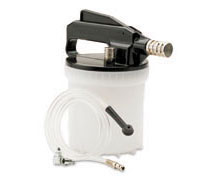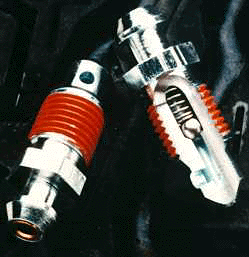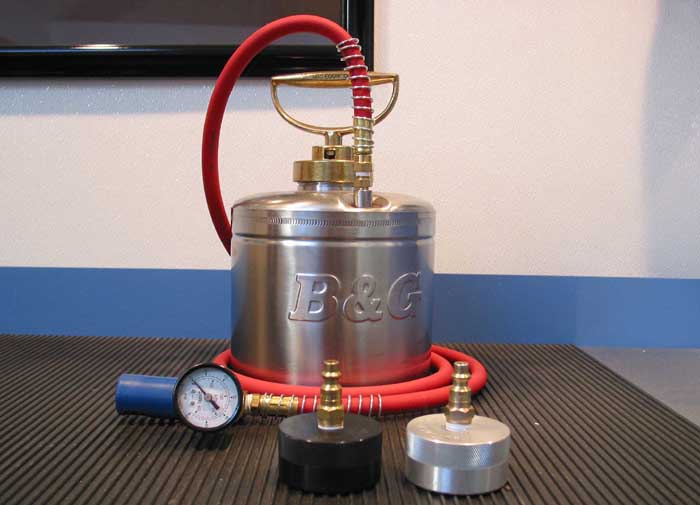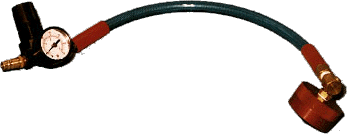I don't like
the concept of a 1-man bleeder 'cause it doesn't give you as good a bleed.
There are several different types of devices which all claim to be "one-man
bleeders" and I'll tell you what I think of each:

1. MyteVac suction pump - don't bother! The reservoir is too tiny on
this device to allow it to hold enough fluid to bleed the brakes. You'll find
your self emptying the reservoir every couple minutes. And it doesn't generate
enough vacuum to pull out any bubbles that are clinging to the walls of rough
inner castings on the caliper or bubbles that need to travel any distance
downhill. This is simply a very frustrating tool to use.

2. Vacula suction device (or any venturi-based device that you hook
to your air compressor). These devices are slightly better than the MyteVac,
yet they still don't generate enough force to effectivly remove bubbles. Also,
air leaks past the rubber boot, making it impossible to know if the stream
of bubbles running down the plastic tube came from your brakes or came from
the imperfect seal around your bleed screw. I use mine as an expensive vacuum
cleaner to remove extra fluid from the reservoir before I bleed the brakes
"properly" with a different technique.

3. SpeedBleeders. These devices are 1-way valves which permanently
replace your caliper bleed screws. They claim to allow 1-person bleeding,
but don't really work well for a number of reasons. I've installed about 10
sets of these and have found a failure rate of nearly 50 percent. The "1-way"
valves too often aren't really 1-way and stuff gets sucked back into the caliper
between pumps. Another reason I don't like them is that, if you are in the
car pumping the brake pedal, there's nobody watching the plastic hose between
the SpeedBleeder and the catch bottle. You don't know when the air bubbles
stop coming out, you can't tell when the old, rusty brake fluid has been flushed
and new, clean stuff is coming out. And worse, if the plastic hose pops off
the SpeedBleeder, you will be pumping brake fluid all over the inside of your
wheel well and possibly onto the side of your car. (Brake fluid eats paint!)
Finally, the SpeedBleeders don't generate enough of a "jolt" on the fluid
to knock loose the pesky bubbles clinging inside your calipers. You need a
2nd person cracking open that bleed screw slightly AFTER you push on the brake
pedal. And that would totally eliminate the need for SpeedBleeders and you
would simply be back to an old fashioned manual bleed.

4. Pressure bleeders - fluid type. These use brake fluid in a large
plastic or metal container and pressurize the car's reservoir with brake fluid.
The benefit is that you don't need to stop to refill the master cylinder reservoir
each time it runs low. And you reduce the liklihood of getting air in the
system because you ran low on fluid. The downside is that you waste a large
quantity of brake fluid since, once you open a bottle, it should be used right
away or discarded. Excellent for replacing fluid. Simply pressurize, then
crack open the bleed screw and wait while the fluid is pushed out into your
catch bottle. But, unless you also combine it with a traditional "assistant
pumps the pedal while you crack the bleed screw open" bleed, then there won't
be enough of a "jolt" to knock loose all the bubbles.

5. Pressure bleeder - compressed air type. This is simply a metal cap
with a fitting for your air compressor. The better ones have a built-in pressure
guage and an adjustable pressure regulator so you can set the pressure to
20 psi. If you go too much higher than 25 psi, you will blow the reservoir
off the top of the master cylinder and I can't even begin to imagine the mess
that you will have to clean up before your paint is dissolved by the fluid!
(You can blow the top off with a fluid type pressure bleeder too.) The compressed
air type of bleeder is my preferred choice since it is compact, easy to take
with you on a trip, and doesn't waste any brake fluid. I find that I can usually
do the front brakes with one fill of the master cylinder reservoir and the
rear brakes on a 2nd fill, meanining the inconvienience of dropping the pressure
to zero, taking it off, refilling the reservoir, and then repressurizing is
really minimal. However, I do NOT consider this to be a 1-man brake bleeder
because I always use an assistant to pump the brake pedal while I crack open
the bleeder screw. Combining the pressure bleeder technique and the traditional
bleeding with an assistant will consistantly give you the best bleed and the
firmest brake pedal.
I strongly advise you to avoid the shortcut of any "1-man bleeder" system
and do it right. You'll be much happier with the end result.
Hope this is helpful.
Dave Z.